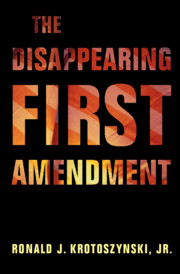Book contents
- The Disappearing First Amendment
- The Disappearing First Amendment
- Copyright page
- Dedication
- Contents
- Preface
- Acknowledgments
- Table of Cases
- 1 Two Steps Forward, One Step Back
- 2 The Public Forum Doctrine and Reduced Access to Government Property for Speech Activity
- 3 The First Amendment As a Source of Positive Rights
- 4 Whistleblowing Speech and Democratic Accountability
- 5 Shedding Their Constitutional Rights at the Schoolhouse Gate
- 6 Transborder Speech
- 7 Systemic Failures to Protect Newsgathering Activities by Professional Journalists and Amateur Citizen-Journalists Alike
- 8 The Citizen As Government Sock Puppet and the State Masquerading As a Citizen
- 9 Using Constitutionally Permissible Statutes to Impede First Amendment Activity
- 10 Conclusion
- Notes
- Index
1 - Two Steps Forward, One Step Back
On the Decline of Expressive Freedoms under the Roberts and Rehnquist Courts
Published online by Cambridge University Press: 02 August 2019
- The Disappearing First Amendment
- The Disappearing First Amendment
- Copyright page
- Dedication
- Contents
- Preface
- Acknowledgments
- Table of Cases
- 1 Two Steps Forward, One Step Back
- 2 The Public Forum Doctrine and Reduced Access to Government Property for Speech Activity
- 3 The First Amendment As a Source of Positive Rights
- 4 Whistleblowing Speech and Democratic Accountability
- 5 Shedding Their Constitutional Rights at the Schoolhouse Gate
- 6 Transborder Speech
- 7 Systemic Failures to Protect Newsgathering Activities by Professional Journalists and Amateur Citizen-Journalists Alike
- 8 The Citizen As Government Sock Puppet and the State Masquerading As a Citizen
- 9 Using Constitutionally Permissible Statutes to Impede First Amendment Activity
- 10 Conclusion
- Notes
- Index
Summary
The contemporary Supreme Court’s approach to enforcing the First Amendment is not unlike Lewis Carroll’s Cheshire Cat: Over time, the Justices have rendered the Free Speech Clause a “grin without a cat,” at least if one believes that the First Amendment, properly construed and applied, encompasses not merely freedom from government censorship, particularly in the form of content and viewpoint discrimination, but also the right to government support for expressive activities related to the project of democratic self-government. By way of contrast, during the Warren Court and Burger Court eras, federal judges routinely required government to facilitate private speech activity. This support came in a variety of forms – including access to government property for speech activity, government employment, extending expressive freedoms to students, faculty, and staff at public educational institutions (including public schools, colleges, and universities), and requiring the government to facilitate, rather than impede or disrupt, newsgathering activities by the press.
- Type
- Chapter
- Information
- The Disappearing First Amendment , pp. 1 - 21Publisher: Cambridge University PressPrint publication year: 2019



